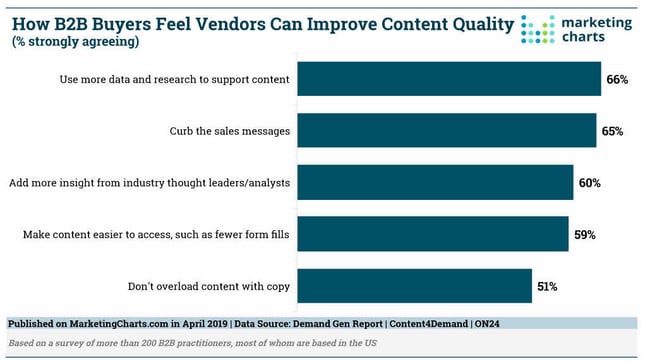 Most sales and business development teams understand that B2B audiences are less influenced by emotion, preferring value-driven content with hard data instead. According to a recent study, 73% of B2B buyers surveyed indicate that they have less time to devote to reading and research than they used to, which makes creating compelling content even more important. However, even with less time available, 60% of B2B buyers still want access to industry insights from thought leaders, opening the door to provide access to this critical audience.
Most sales and business development teams understand that B2B audiences are less influenced by emotion, preferring value-driven content with hard data instead. According to a recent study, 73% of B2B buyers surveyed indicate that they have less time to devote to reading and research than they used to, which makes creating compelling content even more important. However, even with less time available, 60% of B2B buyers still want access to industry insights from thought leaders, opening the door to provide access to this critical audience.
With fewer opportunities available to reach decision-makers, you must demonstrate that you can exhibit thought leadership by increasing quality, demonstrating value, using the right voice, and making content easily accessible.
Quality
Data has always been important to B2B audiences, and recent research indicates that this is not changing anytime soon. When surveyed, 66% of B2B buyers want more hard data from the content they read before making purchase decisions. Overwhelmingly, buyers also have an affinity for timely content, with 90% indicating that they are more likely to engage with content that is related to a topic that they are currently dealing with, working on, or thinking about.
Providing real-world examples, offering new perspectives, and demonstrating thought leadership resonates with B2B decision-makers. However, 72% also feel that brevity is important, placing value on content that conveys critical points succinctly without added fluff.
A 2020 Edelman study reveals that most of these decision-makers spend an hour or more a week reading thought leadership content and 48% report that this thought leadership influences their B2B purchase decisions. Interestingly, 88% say that this content enhances their perception of an organization – garnering respect, increasing perceived capabilities, and improving trust. Furthermore, 41% of decision-makers indicated that they would pay a premium to work with organizations that are thought leaders.
Value
B2B decision-makers have a finite amount of time for reading content, which leads to a strong preference for high-value content. Use infographics, checklists, webinars, and white papers to reach your audiences with the content that they need to make purchase decisions. Align content with the buying journey to provide actionable information and advice.
Data shows that 65% of B2B buyers want less salesy content. Ensure your content is “all meat” by paring it down to omit unnecessary extras. Skip the obvious sales pitch in favor of resolving their problems, easing audience pain points, addressing their concerns, or answering their most pressing questions. Demonstrate an unwavering focus on your audience to form new connections and strengthen existing client relationships.
Voice
B2C content marketers focus heavily on style, tone, and brand voice, strategically planning these elements to communicate and sell more effectively. However, B2B content often does not place as much emphasis on these elements. That is likely one of the reasons why 26% of B2B decision-makers feel that most of the content they read that is intended to act as thought leadership is of mediocre or poor quality. Based on how B2B content is currently perceived, it is clear there is room for improvement.
Conveying honesty and transparency is just as important in B2B applications as it is in B2C spaces. Remember, B2B content can be factual and data-driven without being boring. It may be harder to convey personality in infographics, checklists, and white papers than it is in thought leadership articles but focusing on brand voice is a clever way to make content more engaging and shareable.
Accessibility
It is a common practice for B2B companies to restrict access to their best content in exchange for contact information that feeds into a sales lead pipeline. However, high-value content cannot be effective if no one sees it. Predictably, audiences would prefer to have access to unlocked content and “no strings attached” content. In fact, 59% of B2B buyers strongly agree that they want easier to access content, meaning that they do not want to provide extensive personal information or have to schedule a consultation or demo to get access.
However, giving access to all your best content without getting a lead in exchange can undermine your B2B content strategy, which is why it should not be used arbitrarily. Selectively determining which content can be offered up freely and which should be put behind the wall requires careful consideration. When content is restricted, shorten your forms as much as possible. Ensure you are only asking for the least amount of information necessary to create the lead. Obtain the rest of the information you are seeking later, after you have started the relationship.
What They Want
In short, B2B decision makers want high-quality, data-driven information that makes their jobs and lives easier. The kind of information that provides solutions for their situation and makes them want to buy your product or service without having been “sold.”
Find out more about the benefits of writing articles for a B2B audience or reach out to me here for customized recommendations for your business strategy.
